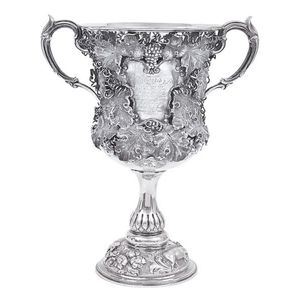Victorian Twin Handled Cup with Hallmarks and Cartouche
You must be a subscriber, and be logged in to view price and dealer details.
Subscribe Now to view actual auction price for this item
When you subscribe, you have the option of setting the currency in which to display prices to $Au, $US, $NZ or Stg.
- Sterling Silver - Sterling silver is a mixture of 92.5% pure silver and 7.5% of another metal, usually copper. Fine silver is 99.9% pure silver, and is relatively soft and the addition of the very small amount of copper gives the metal enough strength and hardness to be worked into jewellery, decorative and household objects.
- Cartouche - An ornamental panel in the form of of a shield, oval or rectangular scroll with curling edges. It may be carved into the back of a chair or the top of a sideboard, or present on a piece of silver or jewellery, and contain the initials of the original owner, heraldic symbols, or some other inscription, such as the details of a presentation.
In ceramics the term defines the central area of a vase or similar with a decorative border in one of the shapes above, into which a decorative scene or figures have been painted. - Hallmarks - A mark stamped on articles of precious metals in Britain, since the 14th century, certifying their purity. It derives its name from the Guild Hall of the Goldsmiths' Company, who recieved its Charter in 1327 giving it the power to assay (test the purity) and mark articles of gold and silver.
The hallmark will consist of several marks, including the:
- silver standard mark, indicating the purity of the metal. Sterling silver is .925 pure silver.
- the city mark indicating the city in which it was assayed eg London, Birmingham, York etc.
- the date mark, usually a letter of the alphabet in a particular font and case,
- a duty mark, indicating whether duty had been paid to the crown, and only in use from 1784 to 1890
The piece may include an additional mark, the maker's mark, although not forming part of the hallmark, will be located in the vicinity of the hallmarks.
Sometimes silver plated items will bear faux hallmarks, often confusing those not familiar with silver markings. - Victorian Period - The Victorian period of furniture and decorative arts design covers the reign of Queen Victoria from 1837 to 1901. There was not one dominant style of furniture in the Victorian period. Designers used and modified many historical styles such as Gothic, Tudor, Elizabethan, English Rococo, Neoclassical and others, although use of some styles, such as English Rococo and Gothic tended to dominate the furniture manufacture of the period.
The Victorian period was preceded by the Regency and William IV periods, and followed by the Edwardian period, named for Edward VII (1841 ? 1910) who was King of the United Kingdom and the British Dominions and Emperor of India for the brief period from 1901 until his death in 1910. - Knop (silver) - A knop on a silver item is either a bulbous protrusion mid way along a stem, such as on a candlestick or at the end of a stem, such as on a spoon, or a knob or finial on top of a cover or lid, that acts as a handle. On a stemmed item such as a candlestick there may be a series of knops of different shapes.
This item has been included into following indexes:
Visually similar items

The 1862, Geelong District Wine Growers sterling silver cup and Australian silver collar the collar attributed to Louis Kitz, (1820-1887), Geelong; the cup with maker's mark Daniel and Charles Houle, London, circa 1859, the two handled cup with an ogee bod

A William IV silver mug, the fluted body with embossed and applied floral designs, spreading circular foot, scrolling leaf decorated handle, gilded interior. London 1834 by Edward, Edward Jnr., John & William Barnard. Weight 198gms. Height 10.8 cm

Sterling silver Victorian Christening mug, with lobed lower body and foot, leaf capped handle, engraved floral scrollw work and vacant cartouche, probably with remant of gilding., London, c1840, maker Joseph II & Albert Savory., height 10.5 cm, weight: 175

Sterling silver Galle Cup, Ceylon Turf club, won by Mr. W. J. Smith's 'Vendetta', mark of Mappin & Webb, Sheffield, 1940, the circular bowl with twin leaf capped scroll handles, supported by four scrolled supports, on a stepped circular foot, mounted on an
